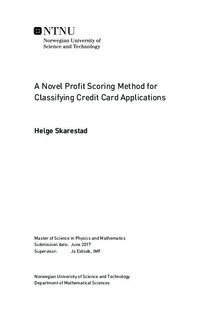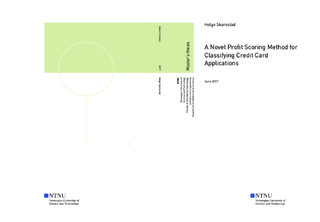| dc.description.abstract | This thesis presents a new scoring method for credit card applications. The method balances the risk and the expected profits an applicant represents to a credit card company. In addition, the EMP cut-off selection procedure introduced by Verbraken et al. [European Journal of Operational Research,238(2),2014] is adapted to credit card scoring methods. In order to test the methods, they are applied to a set of credit card accounts containing observations of the individual net profit margins. A defaulter is defined as an account which, after a year of credit card usage, represents a negative cumulative profit margin. Models for gains, losses and the probability that an account becomes a defaulter are built. The new scoring method is compared to two conventional scoring methods; the probability of becoming a defaulter and the expected profit conditional on the account becoming a defaulter or not. The cut-off selection technique is compared to the conventional methods of maximising accuracy, using efficiency curves and educated guesses of cut-off values.
The results show that the new credit scoring method can outperform conventional methods in terms of profitability when reliable models for gains and probabilities of defaulting can be built. The new cut-off selection procedure can also outperform conventional methods in terms of profitability as it utilises the distribution of losses and average gain. | |

